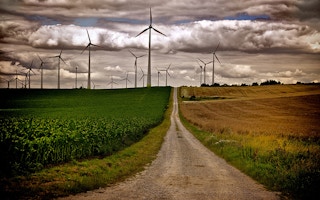A new type of small wind turbine for home electricity generation, intended to match the popularity and potential of solar power, is being developed in Europe.
This will be the second time that attempts have been made by the European Commission (EC) to get wind turbines generally accepted for domestic and small-scale commercial use.
Fifteen years ago, before solar panels became affordable, small wind turbines fixed to house roofs and chimneys were heralded as one of the best ways of helping to save the planet from global warming and cutting household bills, but it was an energy revolution that petered out.
The problem was that the turbines frequently vibrated and made an unacceptable noise, while wind in urban areas was often too turbulent for efficient use.
Although 940,000 small wind turbines were in use around the world by the end of 2014, they are generally uneconomic, and it is a revolution that has yet to happen.
Despite these setbacks, the dream of small-scale turbines has refused to die, and a combination of European Research grants and co-operation between engineers and researchers has led to the development of a new generation of turbines.
“
The new blade design takes consideration of the performance, noise, aesthetic aspect, the cost of manufacturing the turbine and the long-term operational and maintenance costs.
Fernando Aznar, engineer, Small Wind Energy Project
Domestic wind turbines
The EC wants 20 per cent of the bloc’s electricity to come from wind energy by 2020 and believes that, as well as large-scale commercial wind farms being built onshore and offshore in Europe, small domestic wind turbines can also play their part.
An EC-funded small wind energy project (SWIP) has succeeded in producing small turbines with more efficient blades and far lighter turbines.
The idea is that a household with a small turbine, solar power and a back-up battery installed would probably be able to provide all its own power most of the time, and help to stabilise national electricity grids by reducing peaks and troughs in demand.
Fernando Aznar, a Spanish engineer working on the project, has produced a new set of blades that are wider at the tip − a feature which he says improves the turbine’s aerodynamic performance, reduces noise and vibration, and creates more movement to turn the turbine. The design also adjusts the blades so that they sit at the best angle to the wind to reach maximum efficiency.
Airflow around the new blades was studied using sophisticated computer modelling techniques. This allowed the researchers to estimate power production, as well as pitch, torque and thrust, to aid the design of the pitch control system.
“Air flow near to the tip of the blades has a significant impact on the efficiency and the noise from the wind turbine, as well as the aerodynamic force on the blade,” explains Lin Ma, professor of mechanical engineering at the University of Sheffield, UK, who carried out the computer modelling.
“The new blade design takes consideration of the performance, noise, aesthetic aspect, the cost of manufacturing the turbine and the long-term operational and maintenance costs.”
A second problem was the weight of the turbines, which have to work in difficult conditions because in urban and semi-urban areas wind speeds are often low and highly variable.
Heavy turbines can be noisy and do not run smoothly in these circumstances, causing jerkiness called cogging torque, which can cause damage to mountings − as well as annoyance to householders.
Power and efficiency
Jorge Herrero Ciudad, a project manager at Spanish renewable energy company 4fores, has developed a lighter-weight generator that maintains power and efficiency.
When combined with new power conversion electronics developed by the project, it is estimated that this will improve energy harvesting by up to 20 per cent at the most common wind conditions in urban environments.
The new generators are 50 per cent lighter than conventional models. “This has been achieved using cutting-edge design methods and cutting-edge materials,” Ciudad says. “For instance, the structure of the generator uses aerospace-grade aluminium, when typically steel is used.”
A lower-weight generator reduces turbine costs in two other ways. The generators are cheaper as they use less material, and the other parts of the turbine, such as the tower, can be smaller as they have less weight to support.
Wind turbines featuring the new blades and generators are being tested at three different sites that represent three different possible uses − on energy-efficient buildings, shorelines and in industrial areas.
This story was published with permission from Climate News Network.

















